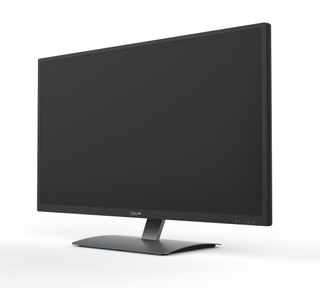Seiki's 40-inch 4K display is a desk-dominating beauty for under $1000

4K monitors are all over CES, but some of the most promising I’ve seen were from Seiki, known for making low-cost displays. Seiki also had a range of 4K TVs on display, but it was the two 4K monitors that caught my eye: one was big, at 32 inches, while the other was huge at 40 inches.
Both monitors looked great, and 4K resolution easily holds up to close scrutiny at 40 inches. For comparison’s sake, a 24-inch 1920x1080 panel works out to about 92 PPI. A 27-inch 2560x1440 monitor is a bit better, at 109 PPI. A 40-inch 3840x2160 monitor, like Seiki’s, comes in at 110 PPI. That’s easily usable without messing with Windows’ still-not-great DPI scaling.
And as huge as 40 inches sounds, the monitor's thin profile kept it from seeming too giant for a decent-sized desk. It certainly doesn't have the massive footprint of old, thick 30-inch 2560x1600 monitors, or the average HDTV, which has a thicker bezel. But it's certainly big; you're going to need a deep enough desk to keep this thing a couple feet away from your nose.
A couple things excite me about Seiki’s monitors other than the size. One: They’re using Samsung Super MVA, or multi-domain vertical alignment, panels. Even if you follow monitor technology, you may not have heard of MVA. TFTCentral can give you a technical breakdown, but essentially VA is a compromise between fast, cheap, often-washed-out TN panels and slower, more expensive, more vibrant IPS panels. I prefer the color quality and much better viewing angles of IPS to TN and think they’re worth the price premium.
VA may be a good alternative. Seiki’s panels did have great viewing angles—definitely better than any TN monitor I’ve used. They’re also claiming a gray-to-gray pixel response time of 8.5 ms (40-inch) and 9.5ms (32-inch), which is just under a frame at 60Hz. And these monitors do support 60 Hz refresh over DisplayPort 1.2 (they don’t have HDMI 2.0 ports, so a single HDMI port can only handle 30 Hz).
Two: price. Seiki plans to launch the 40-inch monitor under $1000 in the next few months. The 32-inch model doesn’t have a release date yet. Seiki explained to me that because production of the 32-inch 4K panels is so limited, the monitor would currently cost more to sell than the 40-inch version. Prices should come down in a few months and make the 32-inch monitor more affordable.
I don’t know yet if VA will be good for gaming. In a quick look at the monitors, I thought colors looked vibrant, but the budget pricing of the monitors may be a deal-breaker when it comes to color depth. They support a disappointing 1.07 million colors, or a 6-bit color depth. That’s far narrower than the 16.7 million colors of most mainstream monitors, and dramatically lower than the 1.07 billion of 10-bit monitors aimed at graphic professionals who need full sRGB support.
The biggest gaming news, reviews and hardware deals
Keep up to date with the most important stories and the best deals, as picked by the PC Gamer team.
10-bit is usually prohibitively expensive for gaming, but 16.7 million is pretty standard these days. Still, the monitors looked great on display at CES, so I wouldn't write them off on specs alone.
4K is all about pushing resolution, but those extra pixels aren’t worth much without brilliant (or, at least, good enough!) color quality to go with them. We’ll have more on Seiki’s 40-inch 4K monitor when we get our hands on a review unit.

Wes has been covering games and hardware for more than 10 years, first at tech sites like The Wirecutter and Tested before joining the PC Gamer team in 2014. Wes plays a little bit of everything, but he'll always jump at the chance to cover emulation and Japanese games.
When he's not obsessively optimizing and re-optimizing a tangle of conveyor belts in Satisfactory (it's really becoming a problem), he's probably playing a 20-year-old Final Fantasy or some opaque ASCII roguelike. With a focus on writing and editing features, he seeks out personal stories and in-depth histories from the corners of PC gaming and its niche communities. 50% pizza by volume (deep dish, to be specific).
Most Popular

